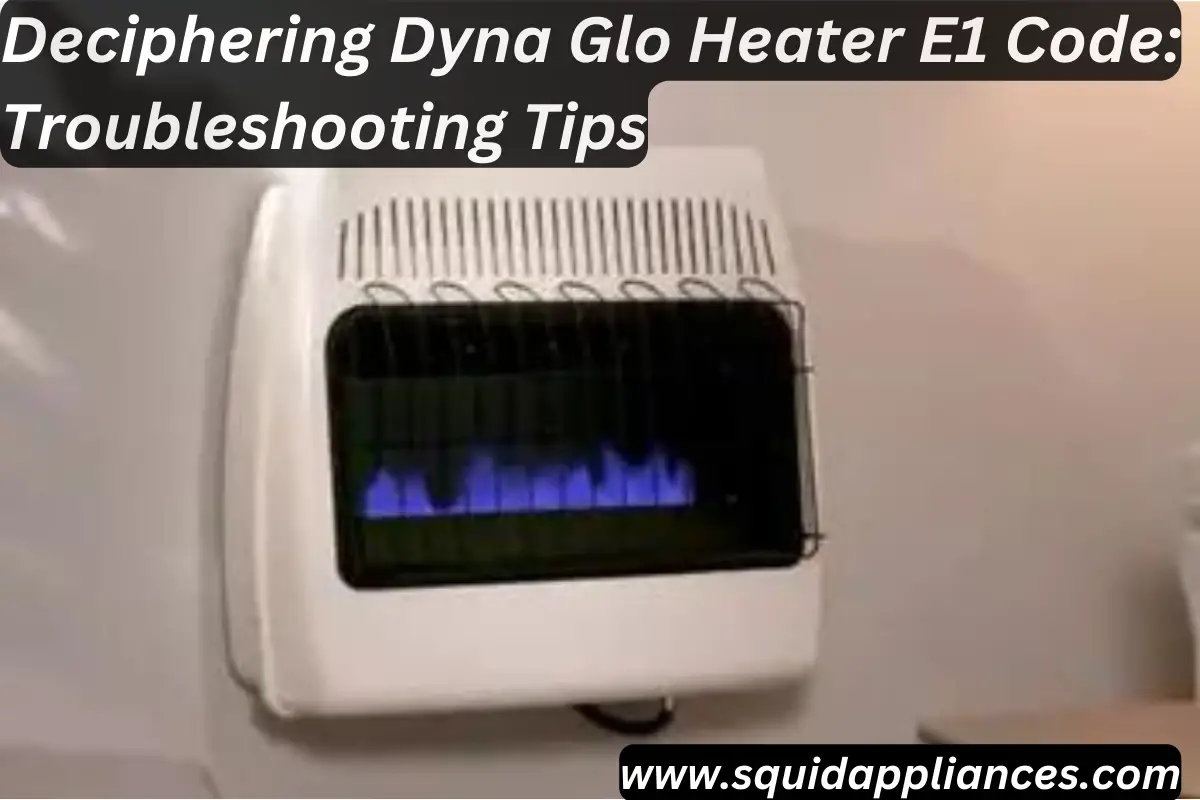If you own a Dyna Glo Heater and have encountered the dreaded E1 code, don’t panic! Understanding and troubleshooting this code can save you time and money.
In this article, I will guide you through the process of deciphering the E1 code and provide you with valuable troubleshooting tips.
Stay tuned for our comprehensive guide on deciphering Dyna Glo Heater’s E1 code and get ready to troubleshoot like a pro!
What are the Troubleshooting Tips for Deciphering Dyna Glo Heater E1 Code?
The article provides detailed troubleshooting steps for deciphering the Dyna Glo Heater’s E1 code, highlighting potential causes like sensor issues or clogged filters. It advises on inspecting connections, checking ventilation, and performing maintenance to prevent future occurrences.
Key Takeaways
- E1 code on Dyna Glo Heater indicates a problem with its operation such as a faulty sensor, clogged filter, or electrical malfunction.
- Troubleshooting steps can help diagnose and resolve E1 code issues, including checking sensor connections, cleaning air vents, ensuring proper ventilation, inspecting electrical connections, and testing power supply voltage.
- Regular cleaning and maintenance, such as cleaning or replacing air filters, removing obstructions from vents, and cleaning the heating element, can prevent E1 code occurrences.
- Seeking professional help is recommended if troubleshooting steps are unsuccessful or if experiencing inconsistent heat output, unusual smells or noises, and frequent E1 code displays. Professional assistance can diagnose and fix underlying problems for safe and efficient heater operation.
Understanding the E1 Code
If you’re seeing the E1 code on your dyna glo heater, don’t worry – I’m here to help you understand what it means and how to fix it!
The E1 code is an error code that indicates a problem with your heater. It could be due to various issues such as a malfunctioning sensor or a blocked air vent.
To troubleshoot this issue, check the sensor connections, clean the air vents, and ensure proper ventilation for your heater.
Common Causes of the E1 Code
One of the most frequent reasons for encountering the E1 code on my heater is due to common issues that can easily be resolved. To fix this problem, I can try a few potential solutions and use some troubleshooting techniques.
First, I should check if there are any loose connections or damaged wires. If not, I can clean the filters and ensure proper airflow. If these steps don’t work, calling customer support may be necessary.
Troubleshooting Steps for the E1 Code
Let’s start by checking for loose connections or damaged wires to tackle the E1 code issue on my heater. Here are some troubleshooting strategies and error code explanations to help resolve the problem:
- Inspect all electrical connections and ensure they’re securely fastened.
- Check for any visible damage or fraying on the wires.
- Test the voltage of the power supply to make sure it’s within the correct range.
- Restart the heater and monitor if the E1 code appears again.
Maintenance Tips to Prevent the E1 Code
To avoid encountering the E1 code on your heater, it’s essential to regularly maintain and care for your heating system. Preventive measures such as regular cleaning can help prevent issues that may trigger the E1 code. Here are some maintenance tips to keep in mind:
| Maintenance Tip | Description |
|---|---|
| Clean the air filter | Regularly clean or replace the air filter to ensure proper airflow. |
| Check for obstructions | Inspect and remove any debris or obstructions that may be blocking the vents. |
| Clean the heating element | Periodically clean the heating element to prevent dust buildup and inefficiency. |
When to Seek Professional Help
If you notice your heater displaying the E1 code and you’re unsure of what steps to take, it may be time to seek professional help. Signs of a malfunctioning Dyna Glo heater include inconsistent heat output, unusual smells or noises, and frequent E1 code displays.
Regular maintenance is crucial for heaters to prevent issues like the E1 code from occurring.
Frequently Asked Questions
What is the warranty period for Dyna Glo heaters?
The warranty period for Dyna Glo heaters is determined by the specific model and varies between 1 to 5 years. For troubleshooting tips, refer to the user manual or contact customer support for assistance.
Can the E1 code be fixed by simply resetting the heater?
Resetting the heater may fix the E1 code issue. However, if it persists, troubleshooting techniques should be employed to identify and resolve the underlying problem.
Are there any specific safety precautions to keep in mind while troubleshooting the E1 code?
When troubleshooting the E1 code, it is crucial to prioritize safety precautions. Before proceeding, ensure the heater is turned off and unplugged. Utilize proper tools and follow recommended troubleshooting techniques to avoid any accidents or injuries.
Are there any potential risks or dangers associated with attempting to fix the E1 code on my own?
There are potential dangers associated with attempting to fix the E1 code on your own. It is important to follow safety precautions and avoid any risks that could lead to injury or further damage.
How often should I clean or replace the filter in my Dyna Glo heater to prevent the E1 code from occurring?
I clean or replace the filter in my Dyna Glo heater every 1-2 months to prevent the E1 code. This cleaning frequency and replacement schedule helps maintain proper airflow and prevents blockages that can trigger the error code.
Conclusion
In conclusion, understanding the E1 code on your Dyna Glo heater is crucial for troubleshooting and maintaining its optimal performance. By identifying common causes such as electrical issues or sensor malfunctions, you can follow the recommended troubleshooting steps to resolve the problem.






